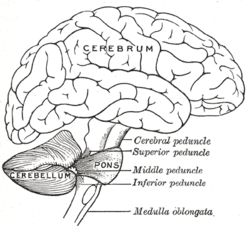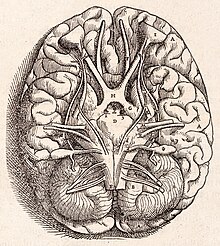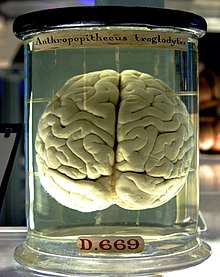User:Kthomas39/sandbox
| Cerebellum | |
|---|---|
 A human brain, with the cerebellum colored in purple | |
 Drawing of the human brain, showing cerebellum and pons | |
| Details | |
| Part of | Metencephalon |
| Artery | SCA, AICA, PICA |
| Vein | superior, inferior |
| Anatomical terms of neuroanatomy | |
Dyschronometria is the medical term to describe a patient who is unable to accurately estimate the amount of time that has passed. This can be a sign of cerebellar ataxia[1] as well as a precursor for a patient who will be having a stroke. Dyschronometria is an Autosomal Dominant Cerebellar Ataxia (ADCA) which usually means the ataxia is a less debilitating than an Autosomal Recessive Cerebellar Ataxia, or an ataxia that is linked to the X- Chromosome[2].

Signs and Symptoms[edit]
When affected with Dyschronometria, spatial awareness on a macro as well as micro scale are compromised. By this the person will lose track of where they are as well as what they may have been doing before hand in a similar way that having poor short term memory has except with location. This seems to only take shape with their short immediate memory as opposed to long term memory as testing has shown. When patients were asked to recall events prior in timelines from as short to a week to as long as many years ago, they were able to recall the memories vividly. This finding leads researchers to question what is it exactly that makes someone forget only briefly what they are doing and where they are.
In Patients with Dyschronometria, keeping track of small amounts of passage of time also proves to be difficult. When asked to wait for thirty seconds, or tap every second that has gone by, those affected will be able to preform the task for a short time and then become quickly derailed by the task. Usually this is because they loose focus however more often than not, the individual affected can no longer tell what they are doing, seeming to become lost. This symptom, while not completely understood, is one of the more obvious to notice for those with this Cerebellar Ataxia [3]. This often takes form in forgetting basic time keeping unless a timer is set, such as when cooking for example. The inability to keep track of time applies only to the keeping track of seconds, minutes and at the most hours. It does not apply however to the macro level having to do with circadian rhythm because they are able to function biological as they had before. This suggests that Dyschronometria is more of a conscious problem as opposed to a passive unconscious one such as what having a dysfunction with circadian rhythms would suggest.
The reason why Dyschronometria is so difficult to recognize even with its easily recognizable symptoms is that it also tends to show up with other Cerebellar Ataxia's that effect Gait, speech and thought process. These other ataxia's also use the same symptoms of lacking spacial recognition and time disorientation to diagnose those ataxia's as well covering up the fact most these patients also have Dyschronometria. The most common ataxia's Dyschronometria has been seem to be evident with are dyssynergia, dysmetria, dysdiadochokinesia, dysarthria as well as the ataxia's effecting stance and gait. Dyslexia is also another problem with those individuals affected by Dyschronometria, however it is unsure weather Dyslexia is developed or worsened by having Dyschronometria, or if it is the exact opposite where having the dyslexia increases the chance to develop dyschronometria. This topic however will be discussed in more detail later in the article.
Some of the most common misconceptions of Dyschronometria have been mentioned above. The greatest of these misconception being that the types of symptoms and signs that look like the patient could have Dyschronometria are either diagnosed as another Ataxia or are truly another Ataxia. Some doctors as well have misconceptions about the symptoms of Dyschronometria. These doctors usually expect to see signs of the Circadian Rhythm being disrupted by either their sleeping cycles and patterns have no logical sense to it. Other misconception included the idea that those who have dyschronometria have a speech impediment or suffer from delusions border lining psychosis, impairment of long term memory, as well as the complete loss of conscious understanding of time. These misconceptions mentioned mostly stem from the fact that this cerebellar ataxia is rarely diagnosed without being seen in dementia or with another ataxia.

Causes[edit]
The greatest common cause of Cerebellar Ataxia's, especially that of dyschronometria, all involve the Cerebellum taking damage. This can be by form of a trauma or by natural causes of disease and genetics. Examples of trauma would be that of a car accident, stroke, epilepsy, and head trauma [4]. These traumas are especially detrimental to Elderly and children due to the decrease in brain matter, thus making these events if taken place have an increased risk of damaging the cerebellum. This also explains why we see dyschronometria more common in elderly due to the deterioration of physical brain matter. Other probable causes for the deterioration of brain matter in the elderly include Increased Supranational Activation, Decreased Cerebellar Activation(Which is consistent with Fronto-Cerebellar dissociation)[5].
As mentioned before several genetic causes exist. These include chicken Pox as well as any version of chicken pox that can infect the nervous system, brain tumors, toxic reactions to released toxins in the blood stream, transient ischemic attacks, Cerebral Palsy, Multiple Sclerosis, Degenerative Disorders, and genetics. Unlike trauma, it is harder to catch the Dyschronometria within those diagnosed with it because it hides beneath these other diseases.
An interesting case of Dyschronometria has to do with Dyslexia. While not completely studied, when Dyslexia was studied within children, they found that these children were often stresses as well as mentally exhausted. This had to do mostly with their inability to understand time and allocate it correctly as well as understanding basic words due to their dyslexia leading on almost a snowball effect to where they had symptoms of Dyschronometria. These children would place little to no importance on their present state, which was a habit that continued into adulthood[6]. This brings about the question of whether Dyslexia is a symptom or a cause of Dyschronometria, or both. When looking into Dyslexia in adults, the question was still unanswered and further research will need to be done in order to completely understand which dyslexia in terms of this cerebellar ataxia is to be classified as.
Lastly, Dementia has a huge effect on Dyschronometria and was one of the main sources of how dyschronometria was discovered. Through studies, Dementia is both a cause and an effect of Dyschronometria. This has to do completely with the fact that with Dementia the brain is constantly rewiring itself and thus information becomes lost causing the person who had dementia to become confused as well as disoriented, and in most causes completely unaware of the passage of time. As a cause, Dyschronometria causes the person to because disoriented and completely unaware of time, thus making bits and piece of their brain involving a memory to become lost ultimately leading to dementia in the long term. This is how Dyschronometria is a precursor to dementia [7].

Diagnosing[edit]
For Dyschronometria as stated previously, diagnosing is extremely difficult due to its symptoms usually being hidden by other ataxias that are related to it. Another problem that Dyschronometria feces in detection is that Dyschronometria is a relatively new name for this side effect and precursor to Dementia compared to other cerebellar ataxia's such as synthesia, yssynergia, dysmetria, dysdiadochokinesia, or dysarthria. When Dyschronometria is detected on the other hand, it is usually found when the symptom has progressed to the point where it can not be reversed or provide any type of benefit for taking the testing medication to either slow down Dyschronometria or the process of dementia setting in which is what dyschronometria is a signal for.
Testing and Diagnosing for Dyschronometria also has shown not to be effective as well. The reason why Dementia is caught so late when the signals seem as obvious as mentioned above is due to the fact that psychological tests that have been done to try to catch signs of dementia, such as Dyschronometria, are not very helpful. This is due to the bell curves that are formed after the statistical analysis, and due to the normal subjects having a wide range, the only patient that is caught by these tests are the subjects that have such an abnormal showing it is obvious even without tests that there is a problem. If there was a way to create a more sensitive testing, perhaps scientists would be able to catch Dementia quicker. [8] Diagnosing of Dyschronometria is also difficult due to the lack of research as well as professionals concentrating in this cerebellar ataxia. Neuroscientists are only just starting to do more research into this lack of awareness and keeping time. When the science and the tests are more specialized and this topic has been looked into at a greater depth, the sensitivity of the tests that have been and will be conducted will be able to give more answer to the questions that are continuing to arise.
Treatments[edit]
The Cerebellum has not been tested clinically with whether or not there is a significance influence by drugs to help the repairmen of various Cerebellar Ataxias. In the research done by Trouillas in Lyon France, it was considered to be logical to examine the pharmacology of cerebellar ataxia by manipulating the key components found at the nerve level within the cerebellum or the inferior Olive. This was done mostly through the modification of the GABA, dopamine, and serotonin receptors which did seem to show positive results in the primary stages of the experimentation. The clinical benefits presented in this study justifying the prescription of d-l-5-HTP or better with the l-5-HTP with benserazide to patients with certain cerebellar ataxias including that of Dyschronometria. At the present as stated, this is the best indication for treatment of the cerebellar cortical atrophies. Even still it is important to stress that the response to this treatment may be slow and irregular.[9]
- Rehabilitation and Plasticity [10]
Further Reading[edit]
- National Ataxia Association
- Dementia: Signs, Symptoms, and Diagnosis
- Journal of Neuroscience
- Society of Neuroscience
- National Ataxia Foundation
External Links[edit]
Category:Neurological disorders
References[edit]
- ^ Lagarde, J.; Hantkie, O.; Hajjioui, A.; Yelnik, A. (2009). "Neuropsychological disorders induced by cerebellar damage" (PDF). Annals of Physical and Rehabilitation Medicine. 52 (4): 360–370. doi:10.1016/j.rehab.2009.02.002. PMID 19874739.
{{cite journal}}: CS1 maint: date and year (link) - ^ Whaley, Nathaniel Robb; Fujioka, Shinsuke; Wszolek, Zbigniew K. (2011). "Autosomal dominant cerebellar ataxia type I: A review of the phenotypic and genotypic characteristics". Orphanet Journal of Rare Diseases. 6: 33. doi:10.1186/1750-1172-6-33. PMC 3123548. PMID 21619691.
{{cite journal}}: CS1 maint: unflagged free DOI (link) - ^ "Cerebellar ataxia". BBC News. 2004-11-30. Retrieved 2007-07-29.
- ^ Tobe, E.H. (2012). "Behavioral Effects of Incomplete Temporal Lobe Necrosis and Cerebellar Damage". Biological Psychiatry. 71 (9): e41–e42. doi:10.1016/j.biopsych.2012.01.005. PMID 22305977.
- ^ Lapresle, J. (1977). [<Go to ISI>://WOS:A1977DG13100009 "Transient achromatopsia in Vertebrobasilar Insufficiency"]. Journal of Neurology. 215 (2): 155–158. doi:10.1007/bf00313063.
{{cite journal}}: Check|url=value (help); Unknown parameter|coauthors=ignored (|author=suggested) (help) - ^ Bruno, J.E.; Maguire, S.R. (1993). "Perception and Allocation of time by Dyslexic Children". Perceptual and Motor Skills. 77 (2): 419–432. doi:10.2466/pms.1993.77.2.419. PMID 8247661.
{{cite journal}}: CS1 maint: multiple names: authors list (link) - ^ Mochizuki, H. (2010). [<Go to ISI>://BIOSIS:PREV201100010038 "Cerebellar Ataxic Gait"]. Brain and Nerve (Tokyo). 62: 1203–1210. doi:BIOSIS:PREV201100010038 (inactive 2023-08-02).
{{cite journal}}: Check|doi=value (help); Check|url=value (help); Unknown parameter|coauthors=ignored (|author=suggested) (help)CS1 maint: DOI inactive as of August 2023 (link) - ^ Shibusawa, Nobuyuki; Hashimoto, Koshi; Yamada, Masanobu (2008). [<Go to ISI>://WOS:000257960400010 "Thyrotropin-releasing hormone (TRH) in the cerebellum"]. Cerebellum. 7 (1): 84–95. doi:10.1007/s12311-008-0033-0. PMID 18418668.
{{cite journal}}: Check|url=value (help)CS1 maint: date and year (link) - ^ Trouillas, P (1984). [<Go to ISI>://WOS:A1984TP61800001 "Regression of Cerebellar syndrome with long-term administration of 5-HTP or the combination 5-HTP-Benserazide"]. Italian Journal of Neurological Sciences. 5 (3): 253–266. doi:10.1007/BF02043955. PMID 6334064.
{{cite journal}}: Check|url=value (help) - ^ Morgan, M. H. (1980). "Ataxia - its causes, measurement, and management". Disability and Rehabilitation. 2 (3): 126–132. doi:10.3109/09638288009163972. PMID 6110638.

